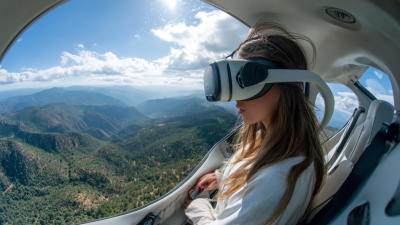Innovative Trends in VR Cinema Movies Unveiled at 2025 China 138th Import and Export Fair
Table of Contents
- Emerging Technologies Revolutionizing VR Cinematic Experiences
- Cultivating Creative Narratives Through Interactive VR Storytelling
- Collaboration Between Filmmakers and Tech Innovators in VR
- Experiential Marketing: Engaging Audiences with VR Cinema
- Showcasing Trends in User-Generated VR Content
- Future of VR Film Distribution and Viewer Engagement Strategies
- FAQS
- Conclusion
- Related Posts
 As the virtual reality (VR) landscape continues to evolve, the intersection of technology and cinema is carving out new avenues for storytelling and audience engagement. Notably, VR Cinema Movies are at the forefront of this transformation, offering immersive experiences that traditional film cannot replicate. According to a recent market report by Research and Markets, the global VR content market is expected to reach USD 57.55 billion by 2027, with a significant portion attributed to innovative cinematic applications.
As the virtual reality (VR) landscape continues to evolve, the intersection of technology and cinema is carving out new avenues for storytelling and audience engagement. Notably, VR Cinema Movies are at the forefront of this transformation, offering immersive experiences that traditional film cannot replicate. According to a recent market report by Research and Markets, the global VR content market is expected to reach USD 57.55 billion by 2027, with a significant portion attributed to innovative cinematic applications.
At the 2025 China 138th Import and Export Fair, these advancements were showcased, reflecting the dynamic growth of the industry. Companies like Guangzhou Longcheng Electronic Co., Ltd., VART VR are leading this charge in China, being one of the earliest manufacturers of VR simulators. With a robust portfolio in VR cinema projects, VART VR is well-positioned to harness these emerging trends, promising to elevate the cinematic experience with cutting-edge technology and creative storytelling.
Emerging Technologies Revolutionizing VR Cinematic Experiences
The 2025 China 138th Import and Export Fair has become a melting pot for the latest advancements in VR cinema technologies. Emerging technologies such as real-time rendering, enhanced motion capture, and AI-driven storytelling are transforming how audiences engage with cinematic experiences. These innovations enable filmmakers to create captivating, immersive environments that blur the lines between fiction and reality, allowing viewers to step inside the narrative in ways previously unimaginable.
At the forefront of this VR revolution is Guangzhou Longcheng Electronic Co., Ltd., known for its premium VART VR offerings. As one of the earliest VR simulator manufacturers in China, the company specializes in providing comprehensive VR and cinema project solutions. Spanning an impressive area of 8,000 square meters and employing over 60 skilled professionals, Guangzhou Longcheng is committed to pushing the boundaries of virtual reality. Their cutting-edge technology and expertise are essential for harnessing the full potential of VR in cinema, setting the stage for a new era of storytelling and entertainment.
Cultivating Creative Narratives Through Interactive VR Storytelling
The evolution of virtual reality (VR) cinema is taking a bold leap forward, particularly highlighted at the 2025 China 138th Import and Export Fair. Interactive storytelling is emerging as a game-changing approach, transforming traditional cinematic narratives into immersive experiences. According to a report by the International Data Corporation (IDC), the global VR market is projected to reach $209.2 billion by 2022, indicating a significant embrace of this technology by both consumers and creators alike. This growing demand for immersive content is pushing filmmakers to experiment with narrative structures that engage viewers in unprecedented ways.

Cultivating creative narratives through interactive VR storytelling allows audiences not only to experience the story but also to participate in it. Recent findings from the Virtual Reality Developers Conference revealed that over 70% of participants felt a stronger emotional connection to the storyline when they were allowed to influence outcomes through their choices. This participatory style helps foster a deeper engagement, as viewers transition from passive recipients to active contributors, reshaping their relationship with the narrative and opening up a new realm of possibilities for storytelling. The future of VR cinema lies in its ability to connect individuals with stories on a more personal level, making every viewing experience uniquely individualized.
Collaboration Between Filmmakers and Tech Innovators in VR
The recent 2025 China 138th Import and Export Fair has spotlighted a groundbreaking collaboration between filmmakers and tech innovators in the realm of virtual reality (VR) cinema. As the industry evolves, this partnership is crucial, as it blends narrative artistry with cutting-edge technology. Filmmakers are now working alongside VR developers to craft immersive experiences that engage the audience in ways that traditional cinema cannot. This synergy promises to redefine storytelling, making viewers not just passive observers but active participants in the cinematic experience.
Tips for aspiring VR filmmakers include investing time in understanding VR-specific storytelling techniques. Unlike conventional films, VR requires a more holistic approach to narrative development, focusing on spatial awareness and viewer agency. Additionally, collaborating with technology experts is indispensable; their insights can guide filmmakers on how to effectively utilize immersive elements. Lastly, experimenting with interactive features can elevate the user's experience, making your project stand out in the competitive VR landscape. Embrace innovation and remain adaptable; the future of cinema is evolving rapidly, and those who lead in creativity will shape its direction.
Experiential Marketing: Engaging Audiences with VR Cinema
At the 2025 China 138th Import and Export Fair, innovative trends in VR cinema movies were showcased, emphasizing the crucial role of experiential marketing in engaging audiences. VR cinema is revolutionizing how stories are told, allowing viewers to immerse themselves in virtual environments where they not only watch but actively participate in the narrative. This shift towards experiential marketing harnesses advanced technology to create unforgettable experiences, thereby forging stronger connections between the audience and the content.
By integrating sensory elements and interactive features, VR cinema transforms traditional viewing into a dynamic adventure. Brands and filmmakers can leverage this approach to invite audiences into compelling scenarios that echo their products or messages, creating a deeper understanding and emotional resonance. As festival attendees explored these engaging VR experiences, it became evident that immersive storytelling in cinema not only captivates but also leaves a lasting impression, making it a powerful tool for modern marketing strategies.
Showcasing Trends in User-Generated VR Content
At the 2025 China 138th Import and Export Fair, a captivating new frontier in VR cinema emerged, particularly in the realm of user-generated content. This trend showcases how everyday creators are now empowered to produce and share their own immersive storytelling experiences. With the advent of advanced VR technology and accessible software, individuals can utilize various platforms to merge their unique perspectives with the expansive capabilities of virtual reality, allowing for an explosion of creativity that transforms traditional filmmaking.

User-generated VR content is revolutionizing how audiences engage with narratives. Instead of merely watching a film, viewers become active participants in the storyline, influencing outcomes and adding depth to the experience. This shift not only democratizes the filmmaking process but also enriches the cinematic landscape with diverse voices and innovative ideas. As evidenced at the fair, the potential for collaboration between amateur creators and established filmmakers promises to cultivate a rich tapestry of storytelling, pushing the boundaries of what VR cinema can achieve in the future.
Future of VR Film Distribution and Viewer Engagement Strategies
At the 2025 China 138th Import and Export Fair, the spotlight was on the innovative trends in VR cinema movies, particularly focusing on the future of VR film distribution and viewer engagement strategies. As the global VR market is projected to reach $57.55 billion by 2027, according to a report by Fortune Business Insights, it underscores the urgency for filmmakers and distributors to adapt to rapidly evolving consumer expectations and technological advancements. This transformative environment encourages a collaborative approach where filmmakers can leverage platforms that enable immersive storytelling through virtual reality, leading to unique viewer experiences that conventional cinema often struggles to provide.
Engagement strategies have also taken a new turn with the integration of interactive features in VR films. Recent studies from Deloitte indicate that immersive experiences can increase viewer retention by up to 40%, emphasizing the potential for immersed audiences to participate actively in narratives. Additionally, the implementation of social VR environments enhances community engagement, allowing viewers to share experiences in real-time, thereby amplifying word-of-mouth promotion. As the industry pivots towards these dynamic distribution channels and interactive engagement methods, it becomes clear that the future of cinema will be defined by the ability to connect and captivate audiences in unprecedented ways, merging technology and artistry for a richer viewing experience.
FAQS
: Experiential marketing in VR cinema focuses on engaging audiences by allowing them to immerse themselves in virtual environments where they can actively participate in the narrative, rather than just passively watching.
VR cinema integrates sensory elements and interactive features that turn traditional viewing into a dynamic adventure, encouraging audiences to connect with products and messages on a deeper emotional level.
The global VR market is projected to reach $57.55 billion by 2027, highlighting the urgency for filmmakers and distributors to adapt to changing consumer expectations and technology.
Filmmakers can enhance viewer engagement by utilizing platforms that support immersive storytelling and integrating interactive features, which can significantly increase viewer retention and participation in narratives.
Recent studies indicate that immersive experiences can increase viewer retention by up to 40%, demonstrating the effectiveness of engaging audiences actively in the narrative.
Social VR environments enhance community engagement by allowing viewers to share experiences in real-time, which can amplify word-of-mouth promotion and create a more connected viewing experience.
Adopting innovative distribution channels is crucial for the cinema industry to meet evolving consumer expectations and leverage technological advancements that create unique and captivating viewer experiences.
Emotional resonance is key in experiential marketing as it helps forge stronger connections between the audience and the content, making experiences more impactful and memorable.
Conclusion
The "Innovative Trends in VR Cinema Movies Unveiled at 2025 China 138th Import and Export Fair" highlights the transformative impact of emerging technologies on the cinematic experience. Key trends include the rise of interactive storytelling, which allows audiences to engage with narratives in a compelling way, and the collaboration between filmmakers and tech innovators to push the boundaries of VR cinema. Additionally, experiential marketing strategies are being developed to captivate viewers, while user-generated content is reshaping expectations of audience participation in VR.
As the industry evolves, the future of VR film distribution and viewer engagement strategies will be crucial. Companies like Guangzhou Longcheng Electronic Co., Ltd. are at the forefront of this revolution, providing comprehensive VR solutions that enhance the accessibility and enjoyment of VR cinema movies. With a dedicated team and extensive experience, they contribute significantly to the innovation and growth of the VR film landscape.
Related Posts
-

Digital Revolution: Discover the Best Commercial VR Simulator 9D Experience for Your Business
-

Exploring the Impact of Virtual Reality Flight Simulator Games at the 2025 China Import and Export Fair
-

Exploring the Evolution of Vr Car Technology and Its Impact on the Future
-

How to Elevate Your Business with Vr Flight Solutions
-

Ultimate Guide to Choosing the Best Vr Driving Simulator for Your Needs
-

The Future of Immersive Racing Game Simulators and Their Impact on Gaming Experience

